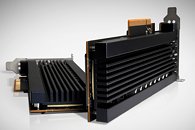
Samsung Unveils 256-Gigabyte 3DS DDR4 RDIMM, Other Datacenter Innovations
Samsung Electronics, a world leader in advanced semiconductor technology, today announced several groundbreaking additions to its comprehensive semiconductor ecosystem that encompass next-generation technologies in foundry as well as NAND flash, SSD (solid state drive) and DRAM. Together, these developments mark a giant step forward for Samsung's semiconductor business.
"Samsung's technology leadership and product breadth are unparalleled," said JS Choi, President, Samsung Semiconductor, Inc. "Bringing 7 nm EUV into production is an incredible achievement. Also, the announcements of SmartSSD and 256GB 3DS RDIMM represent performance and capacity breakthroughs that will continue to push compute boundaries. Together, these additions to Samsung's comprehensive technology ecosystem will power the next generation of datacenters, high-performance computing (HPC), enterprise, artificial intelligence (AI) and emerging applications."
"Samsung's technology leadership and product breadth are unparalleled," said JS Choi, President, Samsung Semiconductor, Inc. "Bringing 7 nm EUV into production is an incredible achievement. Also, the announcements of SmartSSD and 256GB 3DS RDIMM represent performance and capacity breakthroughs that will continue to push compute boundaries. Together, these additions to Samsung's comprehensive technology ecosystem will power the next generation of datacenters, high-performance computing (HPC), enterprise, artificial intelligence (AI) and emerging applications."












